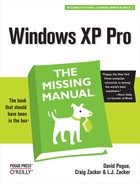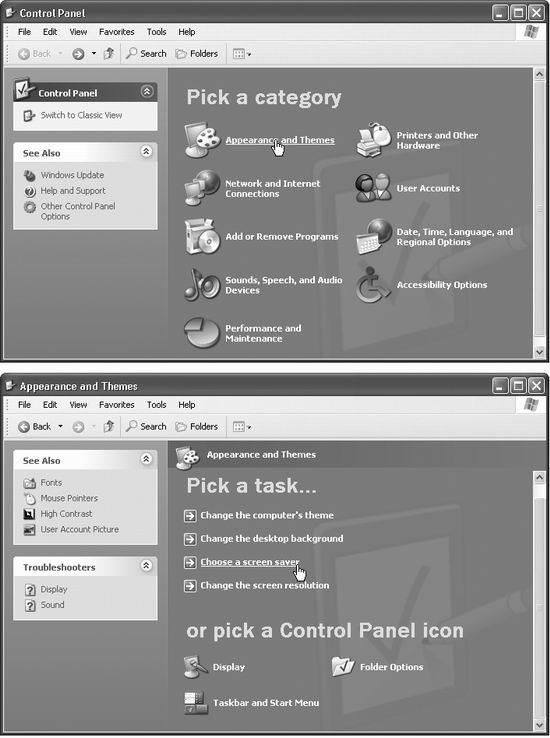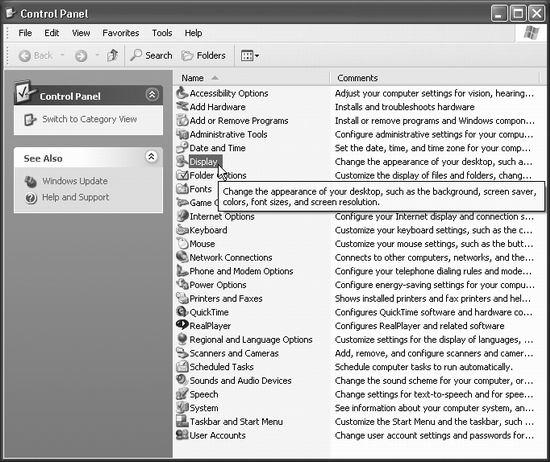The Control Panel is an extremely important window in Windows XP. It’s teeming with miniature applications that govern every conceivable setting for every conceivable component of your computer. Some are so important, you may use them (or their corresponding notification area controls) every day. Others are so obscure, you’ll wonder what on earth inspired Microsoft to create them. This chapter covers them all.
To see your PC’s collection of Control Panel programs, open the Control Panel window by choosing Start→Control Panel.
The first time you see the XP Control Panel, you may be in for a shock. Instead of the list of two dozen programs that used to be there, there are now only nine gigantic icons under the headline, “Pick a category” (Figure 8-1).
Microsoft developed this new design to be friendlier to novices. First click the category heading that you think contains the settings you want to change, such as Appear-ance and Themes. Now you’ll see a second screen (Figure 8-1, bottom) that lists a few common tasks in that category: “Change the desktop background,” “Choose a screen saver,” and so on.
At this point, if you so desire, open the relevant Control Panel program by clicking its icon at the bottom of the screen (Display, in this example). But by clicking the name of the task instead, you’re spared a bit of hunting around, since Windows XP takes you directly to the appropriate tab of the appropriate program.
Tip
If you install software that comes with a Control Panel program of its own, it may not be smart enough to place itself into the correct category. In that case, you’ll find it by clicking the link (in the task pane) called Other Control Panel Options (see Figure 8-1).
Figure 8-1. Top: This new design is Microsoft’s attempt to make the Control Panel look less overwhelming to first-timers. This arrangement groups the existing control panels into functional categories. When you click one of these headings, you’re taken to another new screen. Bottom: The next screen lists the corresponding control-panel icons at the bottom—but, perhaps more useful to the novice, it also lists the useful tasks that those control panels handle.
If you’re a veteran Windows user, the new arrangement of the Control Panel may strike you as just another drag on your efficiency. After all, it places another layer of red tape between you and familiar control panels.
Fortunately, it’s easy enough to eliminate the “Pick a category” display forever: Just click “Switch to Classic View” in the task pane (Figure 8-1, top). Now your programs appear just as they always have, as a tidy collection of individual icons (Figure 8-2).
The rest of this chapter assumes that you’re looking at the list in Classic view—the one that presents an alphabetical arrangement.
Tip
If you’re really a speed freak, even the Classic View method of accessing a particular Control Panel program is fairly inefficient. First you have to choose Start→Control Panel and wait for the window to open, then you have to double-click the individual program you want.
To save time, turn on the feature that lets you choose a certain program’s name directly from the Start menu, as described on Section 1.8.7.
Figure 8-2. If you’re used to the old way of accessing the Control Panel programs, shown here, a single click on “Switch to Classic View” (Figure 8-1) does the trick. Even the standard Control Panel list (shown here in Details view) attempts to be helpful, though—the Comments column describes the function of each program, and tooltips appear when you point to programs without clicking.


